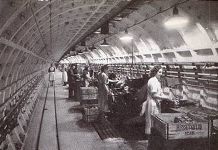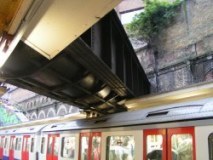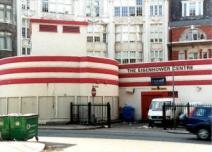When it comes to griping about transport in the capital, Londonist is as guilty as the next blog. But we hope you'll agree that the bus and Tube networks deserve the highest praise this week for their commendable response to the blasts. It is with incredible bravery that thousands of bus drivers were back behind the wheel within hours of the tragedy. One day on, and the Tubes were running an almost full service. So this week, we should forget about all those 'creative' driving skills and petty signal problems and celebrate London's unique and marvellous transport. To help stoke up the enthusiasm, Londonist presents a line-by-line guide to the Wonders Of The Tube. Please proceed by clicking the link below and...mind the gap.
Bakerloo: What's in a name?
The good old poo-coloured Bakerloo line almost went by the cumbersome title of the Baker Street and Waterloo Railway. Londoners can always be relied upon to come up with something better, though (viz. the Gherkin), and the Bakerloo soon became the official name. But not to everyone's approval. The stuffy editor of Railway Magazine was appalled at the vulgarity. "For a railway to adopt its gutter title is not what we expect from a railway company. English railway officers have more dignity than to act in this manner," he moaned, hinting at the American backing of the line. "This is a local railway for local people. There's nothing for you here," he might have continued.
Pub Quiz Fact: Following receipt of a 7 year jail sentence for financial irregularities, head honcho of the early Bakerloo, Whitaker Wright, expired in the law courts after swallowing a cyanide capsule. It was later discovered that Wright had sat through his trial clutching a loaded revolver.

Central Line: Or Should That Be Production Line?
Believe it or not, the Central Line once housed the world's longest factory. During WWII, parts of the completed but unused stretch between Leytonstone and Gants Hill were occupied by the Plessey aircraft company. Sources vary on its length, from 1 mile to 5 miles. (Transport for London take the compromise of 2.5 miles.) Regardless, it was damn long, and required its own miniature railway to transport components amongst the workforce.
Pub Quiz Fact: The Central Line is marginally the longest on the network, at 46 miles. (Piccadilly is next at 44.3 miles.)

Circle Line: Beers In
The Circle Line is the most sociable, sharing its tracks with other lines for almost its entire route. Appropriately shaped like an upended beer bottle, the line is also the setting for one of the most famous pub crawls in the world. Particularly popular with Kiwis, we hear. It takes a special kind of person to complete a drink at each of the line's 27 stops (and no doubt a special kind of station cleaner to work on the Circle Line). Assuming a half-pint at each pub, the trip will set you back about £45. One bunch of nutters do this regularly.
Pub Quiz Fact: The Circle Line has no stations to call its own, always sharing with the Metropolitan, Hammersmith & City or District lines. Poor thing. It takes almost exactly an hour to do a complete circuit.

District Line: A River Runs Through It
The River Westbourne is one of London's vanished rivers. Rising in Hampstead, it once flowed through Kilburn, Bayswater and Hyde Park (via the Serpentine), before spilling out into the Thames near Chelsea. But it has not entirely vanished. Passengers alighting at Sloane Square on the District Line might find themselves puzzling over a large cast iron pipe at ceiling level, near the platform exits. This conduit carries the entire River Westbourne as it makes its subterranean way to the Thames. Miraculously, the pipe survived a direct hit to the station in WWII.
Pub Quiz Fact: The District is the busiest line, with over 180 million passengers a year (three times the UK population).
East London Line: An Incredible Bore
Often overlooked as a Tube backwater, the East London Line contains something very special. Regular readers of this site will know about the twin Thames tunnels at the heart of this short line. These excavations are the oldest tunnels under a major river anywhere in the world, and predate other parts of the Tube network by some 20 years. They were designed by the Brunels, and opened to pedestrians in 1843, becoming a rail route in 1869.
Pub Quiz Fact: The line only has 9 stations, 22% of which are in New Cross. Major extension work is planned to this line over the next few years, but has been delayed several times. With the successful Olympic bid, we should now see some action.

Hammersmith and City Line: Nothing To See Here
Possibly London's dullest line. There's just nothing interesting to say about this one (prove us wrong), so we're going to cheat and tell you about an unusual feature on some nearby Circle/District tracks. If you ever find yourself in Leinster Gardens, W2, look very closely at numbers 22 and 23. The shrubs are well tended, the stucco is well-stuccoed; but nobody's home. The windows are the giveaway – they contain no glass and appear to be painted on. And where are the letterboxes? Well, it's all fake. If you were able to cross the threshold of one of these bogus buildings, you'd plummet onto tracks below. This unusual situation is not some kind of elaborate Dom Jolly-style prank to humiliate unwitting couriers. The Tube rails behind the façade were left open to the air to serve as a point where old engines could literally let off steam, rather than polluting the tunnels. To avoid an unsightly gap in the terrace, the space was bricked up and decorated to match the neighbouring buildings. A couple of trees were planted in front to further enhance the illusion.
Pub Quiz Fact: The Hammersmith and City is the longest-named line on the network. (Sorry, we really are clutching at straws with this unexciting line.)

Jubilee Line: The Jewel In The Crown
The highlight of London's newest line is, of course, the award-winning extension stations between Westminster and Stratford. So, for example, we have such wonders as Canary Wharf station, which is a huge vault large enough to inter the nearby tower if it were laid on its side. And larger still is the practically unused North Greenwich station, which once served the Dome. In fact, this is the largest underground station in the world. Uniquely, most stations on the Jube extension have protective screens on the platforms, to prevent baggage and people falling onto the lines. The extension is also commendable for having twice as many lifts as the rest of the underground put together. Compare that with the Circle Line, where wheelchair users with nothing better to do can board at Westminster and discover that they can't get off again until they've gone full circle.
Pub Quiz Fact: The Jubilee is the only line that connects to all the others. It also has the largest car park, rather pointlessly at North Greenwich.

Metropolitan Line: Did You Know It Went To Chelsea? (Sort Of)
The Met follows the oldest tracks on the network. The first tubes ran from Paddington to Farringdon in 1863, after a three-year construction period. Naturally, excavating the inevitable huge quantities of earth created a mountain of clays and mud. A rather special use was found for this spoil. Having been dumped at Stamford Bridge, the subsoil was used to build the terraces for Chelsea Football Club in 1905. Insert predictable joke about expensive transfer of useless piles/Adrian Mutu here.
Pub Quiz Fact: The Met serves the most distant station from central London: Amersham at 27 miles.

Northern Line: Eisenhower Woz Ere
The Northern was London's first deep level Tube. (Previous lines, such as the Metropolitan are very close to the surface and were constructed by the 'cut and cover' method, rather than by boring.) But it's little known that the line almost had a slightly deeper sibling. Congestion on the route in the 1930s resulted in plans to add a second pair of express tunnels on the Charing Cross branch. During the Blitz, work started on several stations with the immediate aim of providing deep places to shelter for the public. It was hoped that after the war tunnels would be constructed to join the dots. Seven shelters were constructed: Belsize Park, Camden Town, Goodge Street, Stockwell, and Claphams North, South and Common. Most famously, the shelter at Goodge Street was used as a base for General Eisenhower. The plans to link the shelters with express tunnels fell through after the war due to lack of money. The shelters are now used mainly for storage and archiving.
Pub Quiz Fact: Angel station has the longest escalator on the network (60 m).

Piccadilly Line: Ghost stations
The Underground contains many abandoned stations. Quiet, dank places, cut off from time, where the slow drip, drip of stale water is witnessed by the rats alone, and possibly Vincent Price. The Piccadilly Line is replete with these ghost stations, many of which the sharp-eyed passenger can still glimpse through the train windows. Furthest North is York Way, between Caledonian Road and King’s Cross. It closed in 1932 after the surrounding area became derelict. Just south of Holborn is Aldwych Station. This only closed in 1994, but often crops up in films and even games. Fairly close to each other are Down Street and Brompton Road, both of which were closed due to under-use.
Pub Quiz Fact: Leicester Square to Covent Garden is the shortest distance between stations: just 250 metres.

Victoria Line: It's The Pits
The Victoria is a very busy line. Every station (with the exception of Pimlico, which was an afterthought) is an interchange with another Tube line or a mainline rail station. The route took decades to get through planning, and hit its share of delays during construction. In one incident, the boring machine ploughed straight into a long-forgotten plague pit underneath Green Park. Rumour also has it that the line has an access point under Buckingham Palace, as a subterranean means of escape for the royals in an emergency.
Pub Quiz Fact: The Victoria Line is the only line (the piddling Waterloo and City aside) that is entirely below ground.
Waterloo and City Line: The Drain
Last and, well, least is the shortest Tube line, with only two stations. It only joined the network in 1994, but has been running since 1898. The line has had a fairly quiet history and is something of a footnote to the Underground system. It even observes the Sabbath, having never opened on a Sunday.
Pub Quiz Fact: The W&C line is the shortest on the network, at just 1.38 miles of track.
Got any unusual tales or factlets about the Tube? Why not share them here, using the comments form. And while you're at it, visit our favourite Tube blog, at Going Underground.



